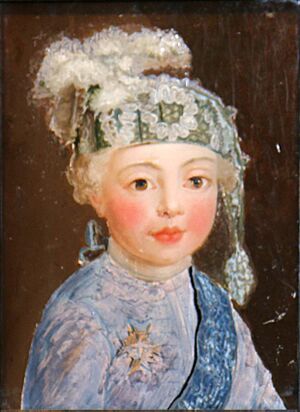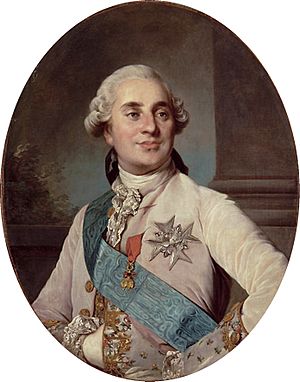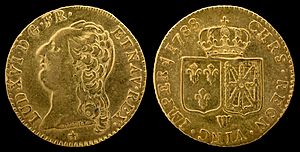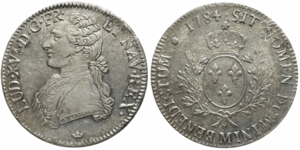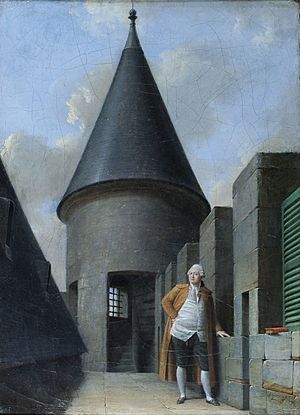Louis XVI facts for kids
Quick facts for kids Louis XVI |
|||||
|---|---|---|---|---|---|
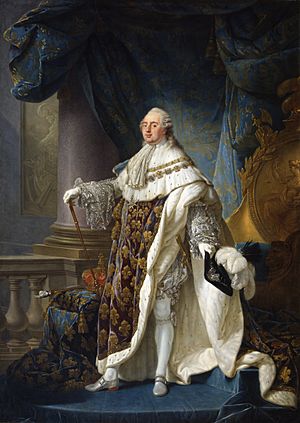
Portrait by Antoine-François Callet, 1789
|
|||||
| King of France (more...) | |||||
| Reign | 10 May 1774 – 21 September 1792 | ||||
| Coronation | 11 June 1775 Reims Cathedral |
||||
| Predecessor | Louis XV | ||||
| Successor | Louis XVII (as disputed King of France) Napoleon I (as Emperor) |
||||
| Born | 23 August 1754 Palace of Versailles, France |
||||
| Died | 21 January 1793 (aged 38) Place de la Révolution, Paris, France |
||||
| Cause of death | Execution | ||||
| Burial | 21 January 1815 Basilica of St Denis |
||||
| Spouse | |||||
| Issue |
|
||||
|
|||||
| House | Bourbon | ||||
| Father | Louis, Dauphin of France | ||||
| Mother | Maria Josepha of Saxony | ||||
| Religion | Catholicism | ||||
| Signature |  |
||||
Louis XVI (born Louis-Auguste on 23 August 1754 – died 21 January 1793) was the last King of France before the French Revolution. He ruled until the monarchy was ended. During the last four months of his life, he was called Citizen Louis Capet before he was executed by guillotine.
Louis was the son of Louis, Dauphin of France. His grandfather, Louis XV of France, was the king. When his father died in 1765, Louis became the new Dauphin of France, meaning he was next in line for the throne. He became King of France and Navarre on 10 May 1774. He reigned until 1791, when his title changed to King of the French. The monarchy was officially ended on 21 September 1792.
Early in his reign, Louis XVI tried to make changes to the French government. He wanted to use new ideas from the Enlightenment, a time of new thinking. These ideas included ending serfdom (a type of forced labor) and making taxes fairer. He also wanted to allow more tolerance for non-Catholics. However, the powerful French nobility did not like these changes. They stopped most of his reforms from happening.
Louis also tried to make the grain market more open, which was suggested by his minister Turgot. This led to higher bread prices. When harvests were bad, people faced food shortages. In 1775, a very bad harvest caused people to revolt in what was called the Flour War. From 1776, Louis XVI supported the American colonists in their fight for independence from Great Britain. This support helped the Americans win in 1783. However, it also left France with huge debts. This financial crisis made the old system of government, known as the Ancien Régime, very unpopular.
The growing unhappiness led to a meeting called the Estates-General of 1789. People from the middle and lower classes were very unhappy with the French nobles and the absolute monarchy. Louis and his wife, Queen Marie Antoinette, were seen as symbols of this old system. Tensions grew, leading to events like the storming of the Bastille. Riots in Paris forced Louis to accept the power of the National Assembly.
Louis's choices and his traditional views made some people see him as a symbol of the unfair Ancien Régime. His popularity kept falling. In June 1791, he tried to escape from Paris, but he failed. This flight to Varennes made people believe he wanted foreign armies to help him regain power. This greatly hurt his trust with the people. Soon, many people wanted to end the monarchy and create a republic. Revolutionaries also started to oppose the church. They ended religious taxes and tried to reduce the church's power.
During a time of war both inside and outside France, Louis XVI was arrested on 10 August 1792. A month later, the monarchy was ended. The First French Republic was declared on 21 September 1792. Louis was then put on trial by the National Convention. He was found guilty of high treason (betraying his country). He was executed by guillotine on 21 January 1793. He was called Citizen Louis Capet by the revolutionaries.
Louis XVI was the only French king ever to be executed. His death ended over a thousand years of continuous French monarchy. His two sons died as children. His only daughter, Marie Thérèse, lived to adulthood. She was later exchanged for French prisoners of war and died without children in 1851.
Contents
Louis XVI: King of France
Early Life and Family
Growing Up in Versailles
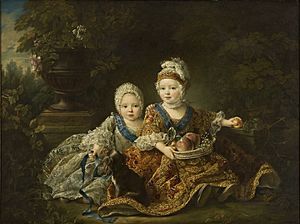
Louis-Auguste de France was born at the Palace of Versailles on 23 August 1754. He was given the title Duc de Berry at birth. He was one of seven children. His father was Louis, the Dauphin of France. His grandfather was Louis XV of France. His mother was Marie-Josèphe of Saxony.
Louis-Auguste's parents often paid more attention to his older brother, Louis, Duc de Bourgogne. His older brother was seen as smart and handsome. Sadly, his brother died at age nine in 1761. Louis-Auguste was a strong and healthy boy, but he was very shy. He was excellent in his studies. He loved Latin, history, geography, and astronomy. He also learned to speak Italian and English well.
He enjoyed physical activities like hunting with his grandfather. He also liked playing rough games with his younger brothers. These were Louis-Stanislas, Comte de Provence, and Charles-Philippe, Comte d'Artois. From a young age, Louis-Auguste was interested in locksmithing. This was seen as a useful hobby for a child.
When his father died in 1765, eleven-year-old Louis-Auguste became the new Dauphin. His mother died two years later. His education was very strict and traditional. It did not fully prepare him to be king. He inherited the throne in 1774 after his grandfather, Louis XV, died. His teachers taught him to be timid. They also told him not to let people know what he was thinking.
Marriage and Royal Children
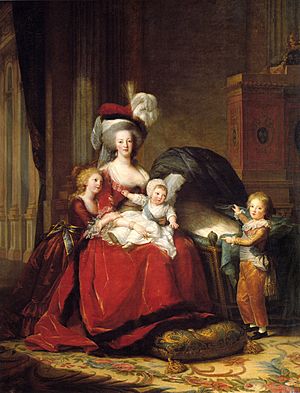
On 16 May 1770, Louis-Auguste was fifteen years old. He married fourteen-year-old Maria Antonia. She was an Archduchess from Austria. She was the youngest daughter of Emperor Francis I and Empress Maria Theresa.
Many French people did not like this marriage. France's alliance with Austria had led to the Seven Years' War. France lost this war to Britain and Prussia. By the time Louis-Auguste and Marie Antoinette married, the French people disliked Austria. Marie Antoinette was seen as an unwanted foreigner. At first, the marriage between the young couple was friendly but distant.
The royal couple had four children who lived:
- Marie-Thérèse-Charlotte (born 1778)
- Louis-Joseph-Xavier-François, the Dauphin (born 1781)
- Louis-Charles, who became Dauphin after his older brother died (born 1785)
- Sophie-Hélène-Béatrix, who died as a baby (born 1786)
Louis XVI also adopted six other children. These were poor orphans or children of servants. Some of them lived with the royal family. Others were supported by the queen.
Becoming King
Early Challenges and Reforms
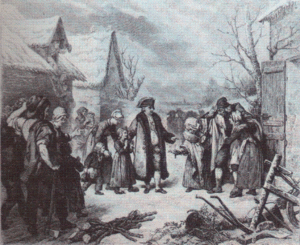
Louis XVI became king in 1774 when he was nineteen. He faced a huge challenge. The government was deeply in debt. People were also growing unhappy with the idea of an absolute king. Louis himself felt he was not ready to fix these problems.
As king, Louis XVI focused on religious freedom and foreign policy. He was smart, but he often struggled to make firm decisions. He wanted his people to love him. He often explained his good intentions in his laws. For example, he brought back the parlements, which were law courts. When asked about this, he said he wanted to be loved. He believed he "must always consult public opinion." He appointed an experienced advisor, Comte de Maurepas. Maurepas helped him with many important tasks until his death in 1781.
A major event in Louis XVI's reign was the Edict of Versailles in 1787. This law gave non-Catholics, like Huguenots (French Protestants) and Jews, legal rights in France. It allowed them to practice their faiths. This edict ended a law that had been in place for over 100 years. It was a big step towards religious freedom in France. It helped reduce religious tensions.
Financial Problems and the Estates-General
The king's financial advisors tried to fix France's money problems. Turgot and Malesherbes suggested big changes. But the nobles and the parlements blocked these ideas. They said the king could not create new taxes. So, Turgot was fired, and Malesherbes resigned.
Jacques Necker took over. He borrowed a lot of money from other countries instead of raising taxes. In 1781, he published a report of the royal finances. This report made it seem like the kingdom had extra money. But it was misleading. When this plan failed, Louis fired Necker. Charles Alexandre de Calonne became the new finance minister. He tried to spend more money to get out of debt, but this also failed.
In 1787, Louis called a meeting of important nobles, called the Assembly of Notables. Calonne told them how bad the debt really was. The nobles were shocked and rejected his plan. Louis XVI and his new finance minister, Étienne-Charles de Loménie de Brienne, tried to force the Parlement de Paris to accept new tax laws. The Parlement refused. Louis tried to use his royal power to make them obey. He exiled them and arrested some members. He even tried to replace the Parlement with a new court.
These efforts failed for several reasons. Most people supported the Parlement against the king. The royal treasury had almost no money. Also, Louis lacked the strong personal authority of past kings. He could only force his decisions for short periods before having to give up.
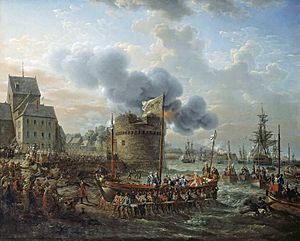
As the king's power weakened, people demanded a meeting of the Estates-General. This was a national assembly that had not met since 1614. Louis XVI finally called the Estates-General for May 1789. This meeting turned the country's problems into the French Revolution.
In June 1789, the Third Estate (common people) declared itself the National Assembly. Louis XVI tried to control them. But this led to the Tennis Court Oath and the storming of the Bastille on 14 July. This event marked the start of the French Revolution. Within three months, most of the king's power went to the elected representatives.
Helping America Gain Independence

France had lost many colonies to Britain in the Seven Years' War. French leaders wanted revenge and to get back their lost lands. In 1776, the Foreign Secretary, Vergennes, saw a chance to weaken Britain. He suggested supporting the American Revolution. Louis was convinced to secretly send supplies and weapons to the American rebels.
In 1778, France signed a formal alliance with the Americans. France then went to war with Britain. Spain and the Netherlands also joined the fight against Britain. France sent large land and naval forces to help the Americans. In 1781, the French navy helped trap a British army at the Siege of Yorktown. This forced the British to surrender.

Britain recognized the independence of the United States in 1783. France gained only a few small colonies from the war. Louis XVI was disappointed he could not get back Canada or India. The war cost France a huge amount of money. This debt made France's financial problems much worse.
Exploring the World
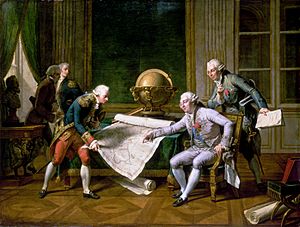
Louis XVI also supported important voyages of exploration. In 1785, he sent La Pérouse on a sailing trip around the world. La Pérouse and his fleet disappeared in 1788. It is said that on the morning of his execution, Louis asked, "Any news of La Pérouse?"
The French Revolution Begins
Life Under the Revolution
Louis XVI's time as a constitutional monarch is not well-known. He felt his "palace was a prison." This period showed how an old system struggled in its final moments.
On 5 October 1789, a large crowd of Parisian men and women marched to the Palace of Versailles. The royal family lived there. The crowd broke into the palace. They tried to harm the queen, Marie Antoinette. She was seen as a symbol of the old, wasteful government. After the situation calmed down, the king and his family were taken to the Tuileries Palace in Paris. The people wanted the king to live among them. This way, he would be more accountable.
The Revolution's idea of people having power was new. It broke from the old idea of kings ruling by God's will. Many people in the countryside and other European governments opposed the Revolution. But in Paris, the monarchy had little support. As the Revolution became more extreme, some leaders worried. Some, like Honoré Mirabeau, secretly tried to help the king regain power. They wanted a new constitutional monarchy.
From 1791, the Foreign Minister, Montmorin, secretly worked against the revolutionaries. Funds meant for the royal family were used to save the monarchy. These plans failed. They were later discovered when a hidden iron chest was found. Louis XVI tried to show he cared about France's financial problems. He even offered to melt down royal silver. But people no longer believed such gestures would fix the economy.
Mirabeau died in April. Louis XVI's indecision also hurt talks between the king and moderate politicians. The leaders of the Third Estate did not want to stop their changes. So, plans for a constitutional monarchy did not last long. Louis was not as against the Revolution as his brothers were. He often told them to stop trying to start counter-revolutions. However, Louis felt like a prisoner in the Tuileries. He was upset that he could not choose his own priests.
The Royal Family's Escape Attempt
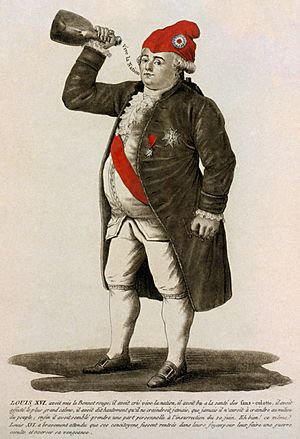
On 21 June 1791, Louis XVI and his family tried to secretly escape Paris. They wanted to reach a royalist fortress town called Montmédy. There, they hoped to join French nobles who had fled the country. They also hoped for protection from Austria. The escape was planned by a Swedish nobleman, Axel von Fersen.
While the National Assembly worked on a constitution, Louis and Marie-Antoinette made their own plans. Louis had appointed Breteuil to talk with other foreign leaders. They hoped to start a counter-revolution. Louis was unsure about relying on foreign help. He thought Austrians were tricky and Prussians too ambitious. As tensions in Paris grew, Louis XVI and the queen decided to escape. They hoped to gather an army with the help of nobles who had left France. They also wanted help from other countries to take back France.
This detailed plan showed Louis's strong will. But it was this plan that later led to him being found guilty of treason. He left a 16-page letter explaining why he rejected the new constitutional system. This letter was printed in newspapers. However, Louis's indecision and delays caused the escape to fail. Within 24 hours, the royal family was arrested at Varennes-en-Argonne. A man recognized the king from his picture on paper money.
Louis XVI and his family were taken back to Paris on 25 June. People now saw them as traitors. They were kept under strict house arrest in the Tuileries. The escape failed because of many small mistakes and delays. Louis also completely misunderstood the political situation. He thought only a few radicals in Paris supported the Revolution. He believed most people still loved him. The king's flight shocked France. People realized war was coming. They felt betrayed, and the idea of a republic quickly grew stronger.
Europe Reacts to the Revolution
Other kings in Europe watched the events in France with worry. They wondered if they should step in. They could help Louis or take advantage of the chaos. Marie-Antoinette's brother, Emperor Leopold II of Austria, was a key figure. At first, he was calm about the Revolution. But he became more worried as it grew more extreme. Still, he hoped to avoid war.
On 27 August, Leopold and Frederick William II of Prussia issued the Declaration of Pillnitz. They said they cared about Louis and his family. They threatened serious consequences if anything happened to them. Leopold saw this as a way to show concern without sending soldiers. But the revolutionaries in Paris saw it as a dangerous foreign attempt to control France.
There were also disagreements over Austrian lands in France. And French nobles who had fled the country were causing trouble abroad. These issues added to the tensions.
Finally, the Legislative Assembly, with Louis XVI's support, declared war on Austria on 20 April 1792. The foreign minister, Charles François Dumouriez, planned to invade Austrian lands. He expected the local people to rebel against Austrian rule. However, the Revolution had disorganized the French army. The soldiers were not ready for battle. They fled at the first sign of fighting. Some even killed their general, accusing him of treason.
While the French government tried to rebuild its army, a Prussian-Austrian army gathered. In July, they began their invasion. They easily took French fortresses. The Duke of Brunswick, their commander, then issued the Brunswick Manifesto. This statement said the Austrians and Prussians wanted to restore the king's full power. It threatened death to anyone who opposed them.
This manifesto did the opposite of what it intended. It greatly weakened Louis XVI's position. Many people saw it as proof that the king was working with foreign powers against his own country. The public's anger exploded on 10 August. An armed mob, supported by the new Paris government, attacked the Tuileries Palace. The royal family found shelter with the Legislative Assembly.
Imprisonment and Execution
The Trial of Louis XVI
Louis was officially arrested on 13 August 1792. He was sent to the Temple, an old fortress in Paris used as a prison. On 21 September, the National Assembly declared France a republic. They also ended the monarchy. Louis lost all his titles. From then on, he was known as Citoyen Louis Capet (Citizen Louis Capet).
Some politicians wanted to keep the king arrested as a hostage. But the most radical members wanted him executed right away. Many deputies found it hard to execute him without a proper trial. So, they voted to try the former king before the National Convention. This trial was seen as the Revolution trying the monarchy itself. Some believed the king's death would lead to a new, happier France.
Two events led to Louis XVI's trial. First, after the Battle of Valmy in September 1792, the Prussians left France. Louis could no longer be used as a hostage. Second, in November 1792, a hidden iron chest was found in the king's bedroom. It contained secret documents and letters. These papers showed Louis had worked against the Revolution. This scandal made it impossible to avoid a trial.
On 11 December, the former king was brought to the Convention. He heard the charges against him: high treason and crimes against the State. On 26 December, his lawyers presented Louis's defense. Before the trial, Louis told his lawyers he knew he would be found guilty and killed. But he wanted them to fight as if they could win. He accepted his fate but wanted to be remembered as a good king.
The Convention voted on three questions. First, was Louis guilty? Second, should there be an appeal to the people? Third, if guilty, what should his punishment be?
On 15 January 1793, the Convention voted on the verdict. Most deputies voted guilty. 693 deputies voted guilty, with 23 not voting. No one voted for him to be innocent. The next day, they voted on his punishment. The decision was very close. 288 deputies voted against death. They wanted imprisonment or exile. 72 voted for death but with delays. 361 deputies voted for immediate execution. Louis was condemned to death by just one vote. His cousin, Philippe Égalité, even voted for his execution.
The next day, a request to delay the death sentence was rejected. 310 deputies asked for mercy, but 380 voted for immediate execution. This decision was final. Louis told his lawyer, Malesherbes, not to cry. He said all eyes would be on him.
His Final Moments
On 21 January 1793, Louis XVI, at 38 years old, was executed. This happened at the Place de la Révolution in Paris. As Louis XVI climbed the scaffold, he looked calm and dignified. He gave a short speech. He said he forgave "those who are the cause of my death." He also said he was innocent of the crimes he was accused of. He prayed that his blood would not harm France. Many accounts say he wanted to say more. But a general in the National Guard ordered a drum roll. The former king was then quickly executed.
Before his burial, a short religious service was held. Louis XVI was buried in an unmarked grave. Quicklime was spread over his body. In 1815, his brother Louis XVIII had Louis XVI's remains moved. They were buried in the Basilica of St Denis. This is the royal burial place for French kings and queens. A monument was built at the original burial site.
Louis XVI's Legacy
How He is Remembered
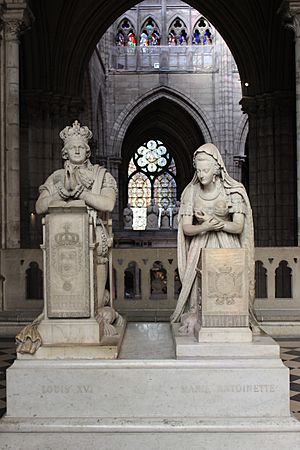
Some historians believe that Louis XVI's execution brought back sympathy for the French monarchy. They felt that even though the monarchy had to end, the royal family's lives should have been spared. They thought the lack of kindness at that moment led to more violence in the Revolution.
Louis's daughter, Marie-Thérèse-Charlotte, survived the Revolution. She tried to get her father recognized as a saint by the Catholic Church. In 1793, Pope Pius VI called Louis a martyr. However, in 1820, the Church decided it could not prove Louis was executed for religious reasons. So, he was not made a saint.
Other ways Louis XVI is remembered include:
- The Requiem in C minor by Luigi Cherubini was written in 1816 to remember Louis XVI.
- A symphony by Paul Wranitzky includes a section called "The Funeral March for the Death of the King Louis XVI."
- The city of Louisville, Kentucky, in the United States, is named after Louis XVI. This was done in 1780 to honor the French king. His soldiers were helping the American side in the Revolutionary War.
Louis XVI in Pop Culture
King Louis XVI has been shown in many films. Actors like Robert Morley and Jason Schwartzman have played him. Some portrayals show him as a clumsy or foolish king. Mel Brooks played a funny version of Louis XVI in The History of the World Part 1.
Louis XVI has also been in books. Some stories imagine what would have happened if he had escaped or been stronger. He also appears in the children's book Ben and Me.
Images for kids
See also
 In Spanish: Luis XVI de Francia para niños
In Spanish: Luis XVI de Francia para niños


